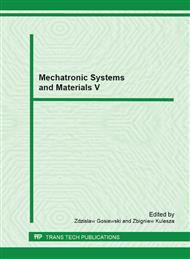p.490
p.496
p.502
p.508
p.514
p.518
p.524
p.531
p.538
The Analysis of the Impact Relative Rolling Reduction at the Area Connector Bimetallic Plate after the Rolling Process
Abstract:
As part of this work the analysis of the impact relative rolling reduction at the connection area of bimetallic plate after the rolling process was carried out. The rolling process was conducted on samples that have been joined by explosive welding method [1-. The scheme of joining bimetallic plates with use of explosive welding method is shown in fig. 1 [. Geometric and structural design of explosively welded connections depends on the type of welded metal, welding process parameters and the thickness of welded components, the geometry of collision, the type of substrate and surface preparation. Regardless of the type of welded metal, there are three basic types of connections obtained with different parameters of welded plates: flat connections without an intermediate layer of the symmetric deformation of grains, wavy connections and the last one with continuous intermediate layer. This paper presents the analysis of sheet metal connection area after direct double-layer combining by explosive welding method and the next stage of their production - the rolling process. Bimetal plates Al99.8-M1E were rolled with relative rolling reduction ε = 10%, 15% and 20%. The analysis of structural changes was made for both kinds of the samples: after the direct connection and after the annealing operations. In addition to analyzing the results of optical microscopy to present a complete picture of changes in the joints the Vickers micro hardness testing were carried out. Fig. 1. Scheme mergers bimetal plate explosive welding method [5]
Info:
Periodical:
Pages:
514-517
Citation:
Online since:
March 2013
Authors:
Keywords:
Price:
Сopyright:
© 2013 Trans Tech Publications Ltd. All Rights Reserved
Share:
Citation:


